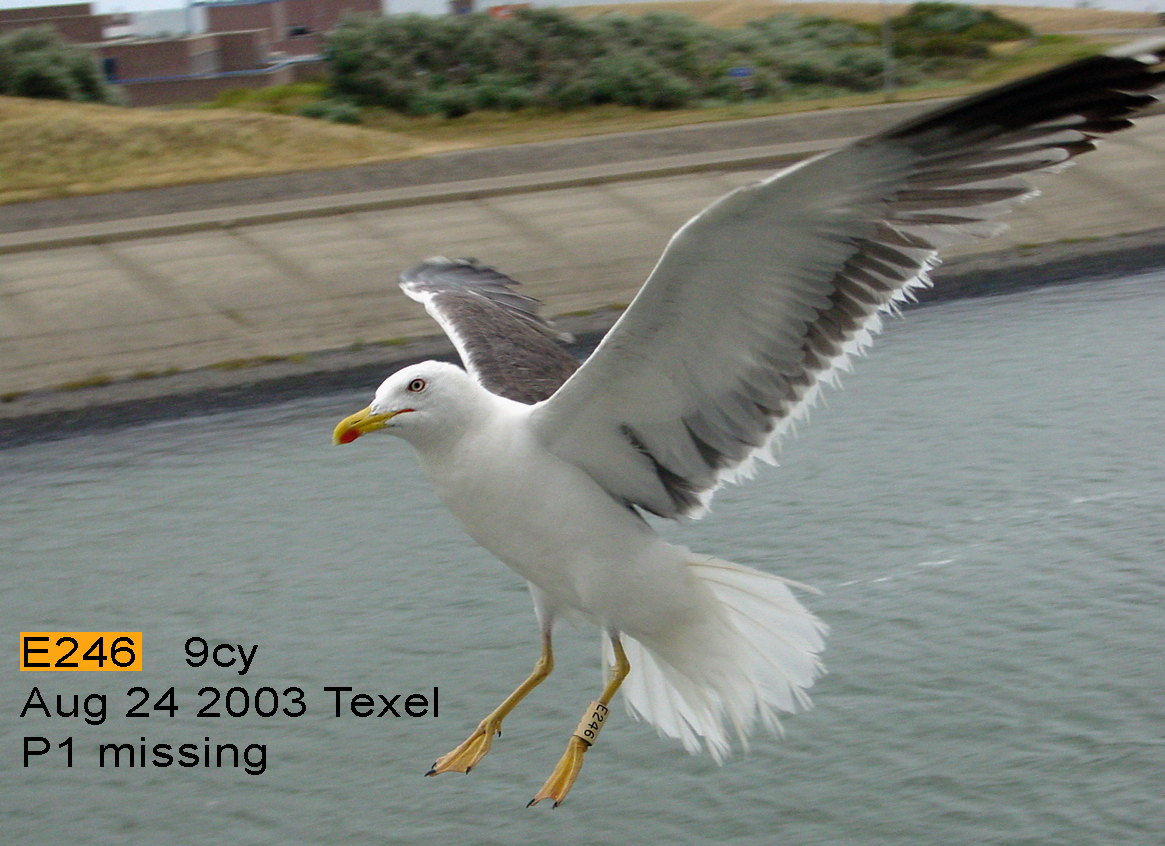 Moerdijk Field Research 2005-2006
Moerdijk Field Research 2005-2006
(last update: 14 August 2010)
Roland-Jan Buijs
Theo Muusse
Mars Muusse
Introduction
Methods
Age, origin & sex
Retrapped Birds
Upperparts Greytone
Black on Primary Coverts
Black on Primaries
P10 and P9 Patterns
P5 Pattern
Red & Black on Bill
Iris & Orbital Ring
Primary Moult
Discussion
References
Primary Moult Scores in May for actively moulting Lesser Black-backed Gulls (n = 187, out of 997 birds. 810 birds still not moulting).
01 May = day 1.
o: Outliers.
*: Extremes.
Numbers of actively moulting birds in % along X-axis.
LBBG showing arrested moult not in this figure, for they are not in ‘active moult’.
On day 23, 11 LBBG were all scored PMS0 (no active moult).
Heuglin's Gull, as is nominate fuscus, is a long-distance migrant to E Africa and the near-East. At the breeding grounds it appears a late moulting species, and images from the wintering quarters confirm this. It's quite normal to find birds still moulting the outermost primaries in January and even February. Such late moulting is not common in western taxa of fuscus. Late moulting may be a good indication for Heuglin's Gull, but there is also a vast period for moult commencement in graellsii and intermedius.
Valery Buzun described the primary moult for heuglini at the breeding grounds, with the commencement of the complete moult between 20 June – 20 July. By mid July, about 25% of breeding heuglini from the islands has moulted P3, while 30% of the tundra breeding heuglini has moulted P4 or even higher by mid July. For Moerdijk we have no data for the period after May. However, in 2003 we have scored 1114 ringed adult (5+cy) breeding LBBG at Maasvlakte (the Netherlands), Zeebrugge (Belgium), and IJmuiden (the Netherlands). These birds belong to graellsii and intermedius populations from the UK, Belgium, the Netherlands, Germany, Denmark, Norway and Sweden.
Primary Moult Scores in ringed 5+cy graellsii and intermedius Lesser Black-backed Gulls in summer 2003 (n = 1114).
01 January = day 1.
The graph below narrows the time period to June-July, to compare data with the finding by Valery. The green dots refer to western LBBG intermedius and graellsii. For the period, we scored 378 ringed adult (5+cy) birds. The green line represents the average moult score in time. The 1st of June can be found on the X axis as day 152. Heuglini breeding on the islands are illustrated in red, heuglini breeding on the tundra is in yellow. The commencement of primary moult is the red triangle, equal to the from mid-June until mid-July.
By mid July, about 25% of breeding heuglini from the islands has moulted P3 (illustrated as P1-P7 still old), while 30% of the tundra breeding heuglini has moulted P4 (illustrated as P1-P6 still old) or even higher by mid July. As can be read from the graph, these groups (25% and 30%) are slightly ahead of the average western LBBG.
Primary Moult Scores in ringed 5+cy graellsii and intermedius Lesser Black-backed Gulls in June-July 2003 (n = 378) and actively moulting heuglini (25% of the island population, 30% of the tundra population).
01 June = day 152.
For heuglini moult, there is more data available in the literature. Visa Rauste (1999) has scored heuglini in Archangelsk, NW Russia in early-September. His data is represented again in the graph below, together with data we have collected in summer 2003 in the period 28 August - 4 September. Despite the rather small sample size for these populations, it is obvious from the figure that there is a rather large range of moult scores by early September. Secondly, the figures indicate that graellsii is somewhat ahead of intermedius, with less old primaries present; and on average, heuglini is somewhat behind compared to intermedius, with the complete moult only just started in some heuglini (9 old primaries present). But also, there is quite some overlap.
Primary Moult Scores in ringed 5+cy graellsii and intermedius Lesser Black-backed Gulls in the period 28 August - 04 September 2003 (n = 100) and heuglini at Archangelsk, NW Russia.
Finally, the image below represents western LBBG with delayed primary moult. The problem is that such birds may not just be 'the odd individual', but may arrange their moulting in a strategy of first migrating south, and then start moulting (as is commonly seen in nominate fuscus). Still, the timing of such western birds may be earlier in the season than nominate fuscus, as they are not true long-distance migrants. Problem here is that such birds, hypothetically making a rapid migration into Portugal or the coast of W Africa, are hard to find out on the sea, while on the other hand the number of people photographing gulls in W Africa is much lower than in NW Europe. So it will probably take some years before we fully understand the exact moult startegy and timing in autumn western LBBG.
